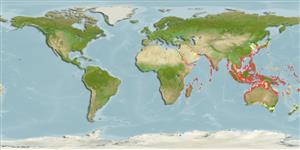Common names from other countries
Environment: milieu / climate zone / depth range / distribution range
Οικολογία
; εύρος βάθους 0 - 40 m (Ref. 349). Tropical
Indo-West Pacific: from East Africa, to Melanesia; north to Japan, and south to northern Queensland and New Caledonia. Apparently rare in Australia.
Length at first maturity / Μέγεθος / Βάρος / Age
Maturity: Lm ? range ? - ? cm Max length : 28.0 cm SHL αρσενικό/απροσδιόριστο; (Ref. 349); common length : 20.0 cm SHL αρσενικό/απροσδιόριστο; (Ref. 349)
Collected for food and for the large, heavy shell in many areas. Mature shell is traditionally used as a trumpet when the tip of the spire is cut off (Ref. 349). Common on inner reef flats and in shallow water near rocky areas, but frequent also offshore. Occurs at the low tide mark. Fasciolariidae are active predators, feeding on tube worms, vermetid and other molluscs (Ref. 349).
Life cycle and mating behavior
Γεννητική Ωρίμανση | Αναπαραγωγή | Γεννοβολία | Αβγά | Γονιμότητα | Προνύμφες
This species is a non-broadcast spawner. Life cycle does not include trocophore stage. Also Ref. 833.
Poutiers, J.M. 1998. (Ref. 349)
IUCN Red List Status (Ref. 130435)
CITES status (Ref. 108899)
Not Evaluated
Not Evaluated
Threat to humans
Harmless
Human uses
αλιεία: Εμπορικό(ά)
| FishSource |
Εργαλεία
Περισσότερες πληροφορίες
Age/SizeΑύξησηLength-weightLength-lengthΜορφολογίαΠρονύμφεςΑφθονία
Διαδικτυακές πηγές
Estimates based on models
Preferred temperature
(Ref.
115969): 24.1 - 29.1, mean 28.1 (based on 1234 cells).
Vulnerability
Low vulnerability (18 of 100).
Price category
Unknown.
